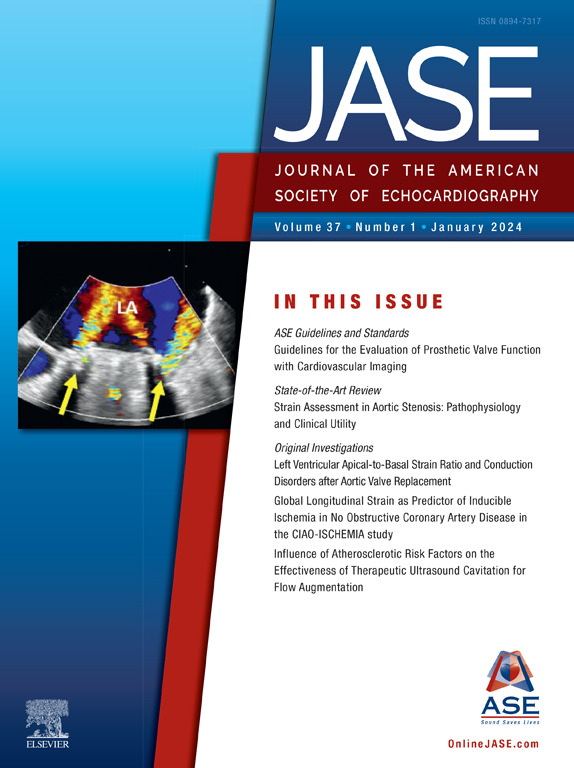Association With Outcome of the Regurgitant-Volume Adjusted Right Ventricular Ejection Fraction in Secondary Tricuspid Regurgitation
IF 5.4
2区 医学
Q1 CARDIAC & CARDIOVASCULAR SYSTEMS
Journal of the American Society of Echocardiography
Pub Date : 2025-06-01
DOI:10.1016/j.echo.2025.01.008
引用次数: 0
Abstract
Background
In patients with secondary tricuspid regurgitation (STR), right ventricular ejection fraction (RVEF) may not accurately reflect the actual RV systolic performance since a considerable amount of the RV stroke volume (SV) is regurgitated back into the right atrium. To overcome this limitation, we explored the association with the outcome of the effective RVEF (eRVEF), which accounts for the tricuspid regurgitant volume (RegVol).
Methods
Five hundred thirteen patients with STR (mean age 75 ± 13 years, 39% atrial STR, 58% severe) underwent complete two-, three-dimensional, and Doppler echocardiography. The eRVEF was computed as RV forward SV/RV end-diastolic volume, where forward SV was obtained by subtracting the tricuspid RegVol from the total RVSV. The end point was a composite of all-cause death and heart failure hospitalization.
Results
After a mean follow-up of 18 ± 15 months, 195 patients (38%) reached the composite end point. At time-dependent receiver operating characteristic analysis, eRVEF (area under the curve [AUC] = 0.72; 95% CI, 0.68-0.77) showed a stronger association with outcome than RVEF (AUC = 0.65; 95% CI, 0.59-0.70; P = .006), tricuspid annular plane systolic excursion (AUC = 0.64; 95% CI, 0.59-0.69; P = .01), RV free-wall longitudinal strain (AUC = 0.63; 95% CI, 0.58-0.68; P = .003), and RV fractional area change (AUC = 0.55; 95% CI, 0.50-0.60; P < .001). The eRVEF cutoff associated with an excess event rate was 20% on spline curve modeling. Patients with eRVEF <20% demonstrated a higher rate of events at 2 years (65% ± 6%) than those having an eRVEF ≥20% (22% ± 7%, log-rank <0.0001). An eRVEF <20% was associated with a 3-fold increased risk of experiencing the composite end point (hazard ratio = 3.54 [2.61-4.79], P < .001). On different models of multivariable analysis, eRVEF as a continuous variable remained independently associated with the combined end point (hazard ratio = 0.96; 95% CI, 0.94-0.98; P < .001).
Conclusions
In patients with STR, eRVEF was more closely associated with all-cause mortality and heart failure hospitalizations than RVEF and other conventional echocardiographic indices of RV function.
继发性三尖瓣反流患者右心室射血分数与反流容积调整结果的关系。
背景:在继发性三尖瓣反流(STR)患者中,右心室射血分数(RVEF)可能不能准确反映实际的右心室收缩性能,因为相当一部分右心室卒中容积(SV)被反流回右心房。为了克服这一局限性,我们探讨了有效RVEF (eRVEF)与三尖瓣反流容积(RegVol)的关系。方法:513例STR患者(平均年龄75±13岁,39%心房STR, 58%重症)行完整的二维、三维和多普勒超声心动图检查。eRVEF计算为RV前向SV/RV舒张末容积,其中前向SV通过从总RVSV中减去三尖瓣RegVol得到。终点是全因死亡和心力衰竭住院的综合。结果:平均随访18±15个月后,195例患者(38%)达到复合终点。在时间依赖性受试者工作特征分析中,eRVEF (AUC 0.72, 95%CI 0.68-0.77)与预后的相关性高于RVEF (AUC 0.65, 95%CI 0.59-0.70, p=0.006)、三尖瓣环面收缩漂移(AUC 0.64, 95%CI 0.59-0.69, p= 0.01)、RV自由壁纵向应变(AUC 0.63, 95%CI 0.58-0.68, p= 0.003)和RV分数面积变化(AUC 0.55, 95%CI 0.50-0.60, p)。在STR患者中,eRVEF与全因死亡率和心力衰竭住院率的关系比RVEF和其他常规心室功能超声心动图指标更为密切。
本文章由计算机程序翻译,如有差异,请以英文原文为准。
求助全文
约1分钟内获得全文
求助全文
来源期刊
CiteScore
9.50
自引率
12.30%
发文量
257
审稿时长
66 days
期刊介绍:
The Journal of the American Society of Echocardiography(JASE) brings physicians and sonographers peer-reviewed original investigations and state-of-the-art review articles that cover conventional clinical applications of cardiovascular ultrasound, as well as newer techniques with emerging clinical applications. These include three-dimensional echocardiography, strain and strain rate methods for evaluating cardiac mechanics and interventional applications.

 求助内容:
求助内容: 应助结果提醒方式:
应助结果提醒方式:


